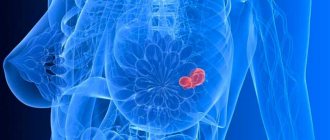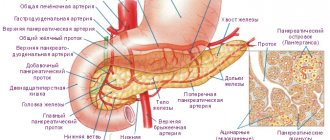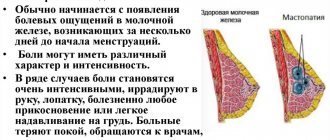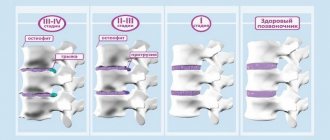1533
0
Most often, cancer is diagnosed in women over 30 years of age, when the production of the hormone estrogen begins to become more active. Risk factors also include heredity and frequent abortions. Prevention sometimes includes childbirth and long-term breastfeeding.
Stage 1 is characterized by a very small tumor - no more than 2 centimeters. At the same time, the cancer has not yet spread to the nearest tissues and lymph nodes, there are no metastases.
When the disease is detected at this stage, the prognosis is most often quite positive, treatment is effective, and the percentage of those cured is close to 100.
What is breast pathology?
Breast cancer (BC) is a malignant tumor formed by the tissues of this organ - ducts or lobules. The division of this disease into stages, accepted in oncology, makes it possible to assess the extent of the prevalence of the tumor process and select an adequate treatment strategy accordingly.
Schematic representation of breast cancer cancer
If we talk about stage I breast cancer, then this is the mildest form of the disease, which, subject to effective treatment, has a high chance of success. This stage includes malignant tumors that do not exceed 2 cm in diameter, without metastases to the lymph nodes and other organs. According to the international TNM classification, where T (tumor) indicates the size of the tumor, N (nodes) - the presence of metastases in regional lymph nodes and M (metastasis) - the presence of distant metastases in other organs, this stage is designated T1N0M0.
In countries where there is no mass screening of women for the purpose of early detection of cancer, malignant tumors in most cases are diagnosed at later stages, since at stage I breast cancer practically does not manifest itself.
How to detect breast cancer in time: Elena Malysheva tells (video)
Risk factors and causes
Most scientists tend to believe that breast cancer is caused by either genetic or hormonal disorders. These are 2 large groups of factors, within which there are various causes that arise either through the fault of the patient himself (an unhealthy lifestyle, etc.), or regardless of his will (for example, genetic predisposition).
The main causes of breast cancer are:
- heredity (if close relatives have been diagnosed with breast cancer, there is a high probability of a tumor);
- earlier onset and late cessation of menstruation (at 11–12 and 55–60 years, respectively), which indicates increased estrogen activity, leading to the formation of hormone-dependent tumors;
- absence of children in women or late first birth (after 35 years);
- malignant processes in other organs;
- gene mutations;
- exposure to radiation;
- the presence of benign formations in the mammary glands;
- low physical activity;
- bad habits (smoking and drinking alcohol);
- taking hormonal drugs;
- obesity (especially in postmenopause).
Obesity contributes to the appearance of breast carcinoma
Classification of breast cancer
Malignant neoplasms can be invasive or non-invasive. The first group of tumors has the ability to grow into adjacent breast tissue, while the second does not.
Non-invasive forms of breast cancer include the following:
- Lobular carcinoma is localized within a lobule of the mammary gland and is formed by its tissues.
- Ductal carcinoma is located inside the milk duct. Moreover, in advanced stages, this tumor is capable of changing its non-invasive nature to the opposite, growing into the surrounding tissues. Such a neoplasm will already be called infiltrating ductal carcinoma.
- Papillary carcinoma is a type of malignant tumor, the structure of which contains cystic inclusions filled with bloody contents.
Non-invasive types of breast cancer are considered unspecified, i.e. not having specific signs, as a result of which their type and nature can be accurately determined only as a result of a laboratory study of the material removed during the operation - this is impossible to do in advance. Such new formations include:
- Medullary cancer has an insidious nature, sometimes masquerading as a benign tumor and appearing on a mammogram with clear outlines and demarcation from healthy breast tissue.
- Mucinous carcinoma is a malignant neoplasm with a mucous structure.
- Lobular carcinoma - originates from the tissues of the breast lobule, does not have a traditional tumor structure, but rather is a compaction or swelling.
In addition to the listed types, there are special forms of breast cancer:
- Paget's disease - squamous cell carcinoma of the areola, accompanied by weeping eczema and discharge from the nipple;
- mastitis-like cancer, accompanied by swelling and inflammation of the breast, which in some cases is fraught with diagnostic errors;
- highly malignant armored cancer, transforming the area of skin above the tumor into a “lemon peel” with a bumpy, thickened surface;
- carcinoma, accompanied by sharply limited hyperemia of the skin of the chest, reminiscent of erysipelas.
In addition, malignant tumors can be hormone-dependent, i.e., having receptors for estrogen and progesterone, and hormone-independent, without such receptors. Tumors of the first type exhibit sensitivity to hormones, which in this case can be effectively used to treat such tumors. Hormone-independent tumors are sensitive to Herceptin, which is also used for successful therapy.
Triple-negative cancer is extremely rare, in which the tumor lacks both type 1 and type 2 receptors.
The most common location of the tumor is the upper outer quadrant of the mammary gland
What will the doctor do?
A clinical breast examination will identify abnormalities or warning signs of cancer before further tests are required. Photo: Vk.
Adult women of all ages are encouraged to perform breast self-examination. This should be done at least once a month in order to find something unusual in time.
Clinical examination of the mammary glands
A doctor who is trained in how to identify abnormalities or warning signs of breast cancer will conduct the examination in his or her office. The subject will be asked to remove clothing from the upper body. The doctor will then do a series of tests to see if there are any problems. They include:
- Visual check : The person will be asked to raise their arms, place them at their sides, and place their hands on their hips. This may show differences in breast size and shape. The doctor will also look for any rashes, dimples, or discharge from the nipples.
- Manual examination : The doctor will use the pads of his fingers to check the entire breast, armpits, and collarbone for abnormalities and suspicious lumps. They will also check the lymph nodes if they are enlarged.
- Evaluation : If a lump is detected, its size, shape and texture will be recorded. The doctor will check to see if there are signs of cancer, or if it is more likely to be a benign tumor or cyst. In any case, further research of the tumor will be required.
Other tests
If a lump is found, the person will undergo further diagnostic tests, which include:
- Mammography : breast x-ray.
- Ultrasound : sound waves that do not damage or affect the body.
- MRI : Inside the machine, a magnet will transmit magnetic energy and radio waves to make a detailed picture of the breast.
- Biopsy : Tissue or fluid is removed from the suspicious area and sent for further tests.
If anyone has any concerns, they should immediately see a doctor who will perform a clinical breast examination.
Sources:
- www.nationalbreastcancer.org (English)
- www.cancer.gov/…/cancer-terms?cdrid=638207 (English)
- www.breastcancer.org/…/vasc_lymph_inv (English)
- www.cancer.org/…/american-cancer-society-guidelines-for-the-early-detection-of-cancer.html (English)
Updated: January 2020.
Rating:
[Total votes: 7 Average rating: 5]
Similar articles:
- What are the early signs of oral cancer?
- What are the early signs of tongue cancer?
- Signs and symptoms of medullary thyroid cancer
- Is breast asymmetry associated with cancer...
- Childbirth may increase risk of breast cancer
- Symptoms of metastatic breast cancer in...
- 8 Signs of Breast Cancer Beyond Lumps
- How long do people live with stage 3 breast cancer?
- Grilled meats may increase the risk...
- Just two sausages a week may increase your risk of cancer...
- Reduce your alcohol intake to reduce your risk...
- What happens at each stage of breast cancer?
Causes and factors for the development of breast cancer
Unfortunately, to date, oncologists have not reached a unanimous opinion regarding the reasons for the development of this oncopathology. In this case, we can only talk about factors that increase the risk of developing a malignant neoplasm. These factors include:
- premenopausal period (40–45 years);
- increased estrogen levels, including estrogen hormone replacement therapy and oral contraceptives;
- negative heredity (breast cancer in close relatives - mother, grandmother, sister);
- the presence of diseases classified as precancerous (fibrocystic mastopathy, diffuse mastopathy, fibroadenoma, etc.);
- early onset of menstruation, late menopause;
- no pregnancies, late first pregnancy;
- unfavorable environmental situation, increased background radiation;
- endocrine diseases, in particular of the thyroid gland;
- excessive consumption of animal fats.
Prevention of breast tumors
Many women who are faced with such an unpleasant disease as breast cancer often ask themselves the question: “How to avoid the appearance of this dangerous disease?”
Experts note that life expectancy depends on the level of estrogen in a woman’s blood. The lowest level of this hormone is observed in a woman during pregnancy and breastfeeding. Because of this, they recommend that all women have children and breastfeed them for as long as possible.
They also note that this is the best way to protect against breast cancer. In addition, they recommend that all women independently monitor their health and hormonal levels. If problems arise, contact a specialist to correct hormonal levels. Also, a woman should not take pills on her own or adjust those prescribed by a specialist.
Experts say that all nulliparous women over 30 years of age are at risk. This group also includes women whose families have relatives who have been diagnosed with breast cancer. Thus, they are recommended to undergo a comprehensive body examination once a year. This will help identify the disease at an early stage and provide timely treatment.
Differential diagnosis
The main task of diagnosis is to differentiate malignant pathology from other diseases of the mammary gland - cyst, papilloma, fibroadenoma, etc.
You can detect a tumor and determine its type and nature using the following diagnostic methods:
- Ultrasound of the breast and axillary lymph nodes - makes it possible to determine the size, location, density of the tumor and the condition of the lymph nodes;
- mammography - allows you to assess the location, shape and boundaries of the tumor;
- fine-needle aspiration biopsy - provides biomaterial for histological examination;
- CT and MRI - in stage I of the disease are rarely used and only in cases where there is uncertainty in the diagnosis.
Ultrasound-guided fine-needle aspiration tumor biopsy
Symptoms
Often precancerous manifestations are visible on the breast. Peeling skin, swelling, sore nipples are not only hormonal imbalances, but also symptoms of infections, cysts or mastopathy. All these pathologies are a manifestation of a precancerous condition. Symptoms of breast cancer that should promptly consult a doctor:
- Nipple discharge. They are observed at all stages of breast cancer. The liquid is yellow-green or transparent. Over time, reddening of the skin of the nipple, ulcers, spots and wounds on the halo form on the chest.
- Lumps in the chest. You can easily feel them yourself.
- Deformation of appearance. When the tumor grows into denser tissue of the mammary glands and metastases appear, the structure of the breast changes (especially in the edematous form or armored cancer). The skin over the lesion becomes purple in color, peeling occurs, and “orange peel”-type dimples are formed.
- Flattened, elongated chest. A sunken or wrinkled nipple is pulled into the gland.
- Enlarged lymph glands. When you raise your arms, you experience pain in your armpits.
Basic treatment methods
In the initial stage of development of the malignant process, treatment in most cases is limited to surgical removal of the tumor and irradiation of the surgical area. Moreover, targeted therapy, chemotherapy and hormonal treatment can also be used according to individual indications.
Surgery
In most cases, stage I breast cancer undergoes lumpectomy—organ-preserving sectoral resection of the breast. If necessary, the sentinel lymph node can be removed for examination through a separate small incision in the armpit.
Complete removal of the organ (mastectomy) with simultaneous or subsequent plastic surgery is used only if the breast is very small and sectoral excision will cause significant damage to it.
Scheme of lumpectomy - organ-saving surgery
Rehabilitation of the patient after lumpectomy occurs quite quickly. If one or more axillary lymph nodes were removed, a complication in the form of lymphostasis of the arm from the operation is possible. This mild swelling can be easily eliminated with light massage and special exercises, which should be started little by little 5-7 days after surgery.
Radiation, chemotherapy and targeted therapy
In order to reduce the risk of local recurrence of the disease after healing of surgical sutures, patients in most cases are prescribed several sessions of radiation therapy.
Conducting a radiation therapy session
Chemotherapy for stage I breast cancer is carried out only for triple-negative cancer and a high degree of malignancy of the tumor (poorly differentiated carcinoma). In these cases, cytostatic drugs Cisplatin, Doxorubicin, Cyclophosphamide, etc. are used.
For hormone-sensitive tumors, after their removal, hormonal therapy with Tamoxifen is also possible.
In addition, according to indications, the oncologist can decide on the advisability of carrying out targeted therapy with drugs that can block tumor growth, affecting it precisely and without causing damage to the body, unlike cytostatics. For hormone-dependent tumors, Femara and Aromasin are used, and for hormone-independent tumors, Herceptin or Avastin are used.
How to detect breast cancer at home, and what are its main symptoms?
Before going to the doctor, a woman, through self-examination and palpation of the breast, will be able to determine the development of cancer in the breast. Every woman should pay attention to the following symptoms of breast cancer:
- The presence of seals on the chest, which are clearly visible. Typically, such neoplasms look like a soft nodule or cartilage. It is as flexible as dough. Doctors note that such neoplasms are round in size. In some cases, their boundaries are unclear. They are smooth or with some roughness. It is noteworthy that such nodules can grow quickly and reach large sizes.
- The appearance of a large number of wrinkles in some areas of the chest.
- Large sizes and swelling in the follicles.
- Change in color of the skin of the nipple. It may become brown, yellowish or even bluish.
- Nipple traction.
- Formation of ulcers.
- Various discharge from the nipple. They can be either transparent or bloody;
- Detection of a nodule with uneven contours on palpation. It is noteworthy that the absence of pain in it indicates the presence of a benign tumor.
- The appearance of mastitis.
- Inability to move the glands towards the pectoral muscles;
- Enlarged axillary lymph nodes.
Thus, if a patient has the above-described signs of oncology, she should immediately contact a specialist.
Does a woman need a special diet?
There are no strict requirements for the preparation of a diet during treatment of the disease. Moreover, the composition of the products consumed should provide the body, which is in a stressful situation, with the necessary supply of nutrients, vitamins and microelements, and ensure the maintenance of normal hemoglobin levels. It is also necessary to reduce the load on the liver, which was damaged as a result of general anesthesia, and, even more so, after chemotherapy, if it was used.
It is recommended to include in the diet:
- dietary meats - veal, chicken, rabbit;
- beef liver dishes;
- dairy products;
- fruits, vegetables, fruit and vegetable juices;
- pomegranate in its natural form and juice from it;
- bananas;
- citrus.
Recommended food products (gallery)
Pomegranate – increases hemoglobin levels in the blood
Fruit and vegetable juices are a source of vitamins (the combination of apple+carrots+beets is especially useful)
Dietary chicken meat
Beef liver dishes have a positive effect on hemoglobin levels
What should not be abused:
- fatty pork;
- fried dishes, grill menu;
- smoked meats;
- marinades, spices;
- canned food;
- alcoholic drinks, including beer.
Foods you should avoid eating (gallery)
Fatty pork
Smoked meats are a burden on the liver
Fried meat (especially grilled) - negatively affects the functioning of the gastrointestinal tract
Beer is an alcoholic drink that you should also temporarily abstain from
First signs
At the initial stage of the disease, the clinical picture is almost always asymptomatic. More often it resembles different types of mastopathy. The only difference is that with a benign tumor the lumps are painful, but with oncology they are not. According to statistics, 70% of women who were diagnosed with cancer were first identified as having a lump in the breast that was easily palpable. The reason to consult a doctor is pain in the mammary gland, even slight. The first sign of cancer is a lump in the breast that does not go away after menstruation.
Prevention
To avoid getting breast cancer, you should remove the risk factors that lead to the disease: bad habits, physical inactivity, stress, poor nutrition. The main measures to prevent breast cancer include:
- regular examinations by a mammologist;
- proper nutrition;
- breastfeeding;
- body weight control;
- no abortions.
Symptoms of breast cancer can be similar to other benign pathologies. Cancer cells can only be reliably identified through a comprehensive examination. But in order not to miss the appearance of the first signs or symptoms of breast cancer, you need to regularly conduct self-examination and medical examination.
Proper breast self-examination
For early diagnosis of breast cancer, it is necessary to regularly undergo self-examination, which allows you to identify the first signs of the disease, including precancerous conditions (mastopathy, inflammatory mastitis, etc.).
How to identify breast cancer? To do this, it is necessary to carry out frequent examinations in front of a mirror and using palpation according to the following algorithm:
- It is very important to examine the bra to identify pathological discharge, which can be either in the form of liquid or in the form of crusts and spots of various types.
- The first stage of assessing the condition of the mammary glands and detecting a tumor is an external examination of the breast: its shape, size in comparison with previous examinations.
- After this, hands are placed behind the head and the mobility and movements of the gland are analyzed. If there are any deviations, asymmetry, retractions of the skin, formation of a flat area, changes in the nipple are detected, then you can suspect a tumor disease and consult a doctor.
- Particular attention should be paid to the condition of the skin: there should be no ulcers, cracks, swelling or other pathological changes.
- The last stage of self-examination is to study the nipple: its shape, elasticity, color, as well as study the tissues around it. There should be no discharge when pressing on the nipple.
- After this, all stages are repeated in a lying position, which improves the percentage of tumor diagnoses in women.
Other symptoms that you can identify yourself
The clinical picture of breast cancer is varied, which makes its diagnosis in oncology a little difficult. Symptoms in women depend on the stage of the process, its prevalence, destruction of nearby tissue, and the presence of metastases.
The main symptom of nodular breast cancer is the presence of a round formation of various diameters (from a few centimeters to 10 cm or more) in the mammary gland. In addition to this, there are other signs that were listed above as the first symptoms, or will be described below.
The diffuse type of tumor is divided into several subtypes: erysipelatous, mastitis-like and armored. These types of cancer in women are very aggressive and differ from nodular and other forms of benign tumors in the absence of growth boundaries. Erysipelas-like and mastitis-like types of breast tumors are necessarily associated with the development of an inflammatory process, which leads to increased body temperature, redness of the skin and tenderness of the mammary gland upon palpation.
Very often doctors confuse these forms of the disease with erysipelas or mastitis, respectively. Such an error leads to the prescription of antibacterial agents and other drugs that are not able to cope with the actual disease. As a result, the tumor grows and develops, worsening the clinical picture and prognosis for the woman’s health.
The armored type of cancer begins with the formation of compactions under the skin, which ultimately form a characteristic dense “shell.” In this case, contraction of healthy breast tissue occurs and its reduction, very often easily noticeable upon external examination.
In a small number of cases, the first symptoms of the disease are associated with the manifestation of symptoms of metastases in the lymph nodes. In this case, the breast tumor is called hidden, since it is quite difficult to detect.
If the size of the tumor is small, then women may not experience symptoms. It is possible to independently detect a node only if the breast size is small or its superficial location. Women with large breasts most often cannot feel such formations in their breasts. In cases where a node is nevertheless detected, it is necessary to evaluate its characteristics: mobility, relationship with surrounding tissues, pain, etc.
A benign tumor is characterized by an elastic structure, mobility in the subcutaneous tissue, smooth edges and slight pain when squeezed. In the case of a malignant neoplasm, the detected irregularly shaped node is fused to the surrounding tissues, practically does not move and is painful even at rest. The inflammatory nature of the compaction can be established on the basis of the addition of intoxication syndrome; in these cases, you should be as careful as possible and not miss mastitis- and erysipelas-like forms of breast cancer.
Signs of tumor malignancy
The malignant nature of the formation is primarily indicated by changes in the skin. Most often, due to the infiltrating and tightening growth of the tumor, the skin takes on a wrinkled or “lemon peel” appearance. In severe cases, the tumor may grow to the surface - then the skin swells and takes on the appearance of a “cauliflower”. However, a similar situation occurs in oncology in women very rarely.
It is important at any stage of breast cancer to pay attention to the axillary lymph nodes, since it is in them that the primary metastasis of the tumor occurs. If the lymph nodes are not changed, painless and not enlarged, then there is no cause for concern. However, changes in their size, consistency, limited mobility and pain are a serious cause for concern, since very often these symptoms reflect the process of tumor metastasis.
A number of patients experience swelling of the shoulder and upper part of the lower limb. These manifestations are also associated with tumor metastasis and impaired lymph outflow as a result of these processes.
To summarize, the main common symptoms of breast cancer are:
- Changes in the shape, size of the mammary glands, as well as nipples.
- Changes in the skin, its color, texture for no apparent reason.
- Detection of lumps in the breast tissue or discharge from the nipples.
- Enlargement of the lymph nodes of the axillary group.
- A sudden onset of intoxication syndrome, accompanied by external changes in the mammary gland and the occurrence of pain in it.
Treatment without surgery
When a malignant tumor occurs in the breast, some patients refuse surgery, radiation and chemotherapy, citing toxicity and side effects. Non-surgical treatment methods include acupuncture, Ayurveda, yoga, massage, and homeopathy. Sometimes alternative treatment methods include hypnosis, reading prayers, therapeutic fasting, and the use of dietary supplements. The effectiveness of these methods has no evidence, so such therapy is a big risk for the patient’s life.
Hormone therapy
Indicated if the malignant neoplasm is sensitive to hormones. To determine this, after examining the mammary glands, an immunohistochemical examination of the biopsy material is performed. Based on the results of the examination, the following medications may be prescribed:
- Estrogen receptor modulators. Prescribed if the tumor has estrogen and progesterone receptors. These drugs include: Tamoxifen, Toremifene, Raloxifene.
- Estrogen receptor blockers. They prevent estradiol molecules from joining estrogen receptors. The most famous medications of the group: Faslodex, Fulvestrant.
- Aromatase inhibitors. Used to reduce the production of the ovarian hormone estrogen during menopause. Exemestane, Anastorazole, and Letrozole are widely used in oncological practice.
- Progestins. Reduce the secretion of pituitary hormones that produce estrogens and androgens. Use tablets for oral administration, vaginal suppositories or ampoules for intramuscular injections. This group of drugs includes: Exluton, Continuin, Ovret.
Radiation therapy
It is not used as monotherapy. The role of radiation exposure in complex treatment increases during organ-preserving operations. Depending on the purpose, lymph nodes or the mammary gland (on the affected side) may be exposed to radiation. Radiation therapy is divided into several types:
- preoperative;
- postoperative;
- independent (for inoperable tumors);
- interstitial (with nodular form).
Chemotherapy
The principle of operation of the method is based on the use of antitumor drugs. They are administered intravenously, drip or orally. The duration of chemotherapy depends on the patient's condition. One course consists of 4 or 7 cycles. The procedure is prescribed both before and after breast removal. For breast cancer, chemotherapy requires individual selection of medications.
Comparison of similar symptoms with other breast diseases
If you find a lump in your breast, do not immediately think that these are cancer cells. There are many common breast diseases with similar symptoms.
Pain and lumps in the chest can occur with:
– Mastitis (inflammation of the mammary gland);
– Mastopathy of the mammary glands (small nodular or extensive diffuse compactions);
– Fibroadenoma (benign neoplasm).
The difference between mastitis and cancerous tumors
Mastitis occurs as a result of injury or infection entering the mammary gland through cracks in the nipple. Most often it occurs in primiparous women who are breastfeeding. Unlike oncology, mastitis develops very quickly literally in the first day after infection or injury.
– diffuse thickening in the chest;
– sharp bursting pain, aggravated by feeding;
– an increase in temperature, both local and general;
– purulent cavities and nodular seals may appear;
– pathological purulent or bloody discharge may be released from the nipple during lactation.
The difference between mastopapia and cancerous tumors
Mastopathy is a disease of non-inflammatory origin; it is a pathological proliferation of the alveoli and ducts of the mammary gland under the influence of hormonal imbalance (increased levels of estrogen, prolactin, decreased progesterone in the blood and gland tissues). There may be nodular and diffuse forms of mastopathy. Fibrocystic breast changes can develop into cancer. Read more about the diagnosis and treatment of breast cysts in a special article on our website. Upon examination and palpation, it is impossible to reliably distinguish mastopathy from cancer; additional diagnostics must be carried out.
– upon palpation, compactions are determined in the form of nodules (like grains) or strands in case of diffuse damage;
– often accompanied by menstrual irregularities and the onset of menopause;
– pain appears gradually as the compaction increases;
– in the future, symptoms of mastitis may appear.
The difference between fibroadenoma and cancerous tumors
Fibroadenoma is a benign neoplasm of glandular tissue, the causes of its occurrence are unknown. There can be two forms of fibroadenoma: mature with clear contours and immature - loose. There is a possibility of degeneration into cancer cells. Differential diagnosis of cancer and fibroadenoma is difficult; additional diagnostic methods are required.
– single or multiple lumps in the mammary gland;
– pain is often absent;
– the skin is usually not changed.











